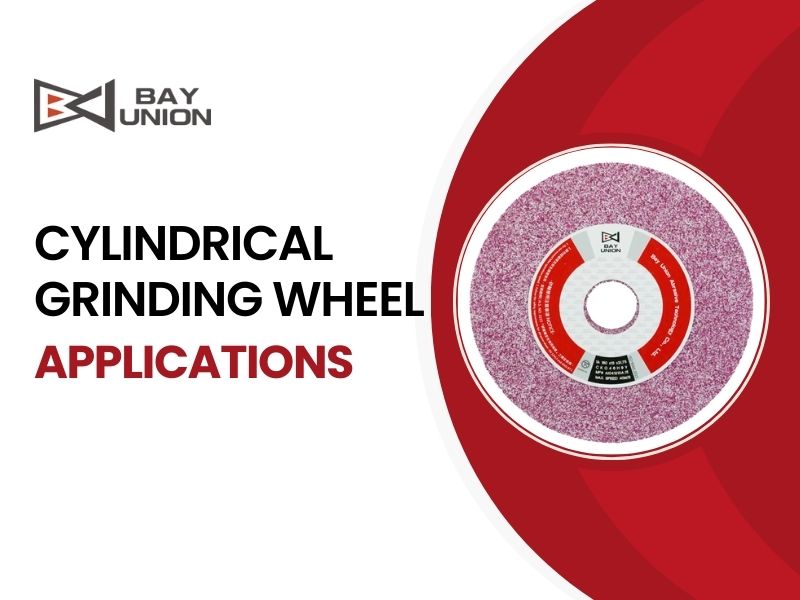- NEWSNEWS
- EXHIBITIONEXHIBITION

Cylindrical Grinding Wheel Applications: Top 5 Insights for Industrial Success
Introduction
Cylindrical grinding wheels are essential in modern precision machining. Designed to grind the outer or inner surfaces of round workpieces, these wheels play a critical role in achieving fine surface finishes, tight dimensional tolerances, and consistent product quality. From automotive shafts to aerospace components, cylindrical grinding ensures the performance and longevity of high-value parts.
As machining demands grow in complexity and accuracy, understanding how to choose and apply the right cylindrical grinding wheel is key to production efficiency and product excellence.
1. Versatility in Industrial Applications
Cylindrical grinding wheels are widely used in both external cylindrical grinding (OD grinding) and internal cylindrical grinding (ID grinding). They are applied across numerous industries to achieve precision in form, diameter, and surface roughness.
Common Use Cases:
- Automotive: Grinding of crankshafts, camshafts, and transmission shafts
- Aerospace: Precision finishing of turbine shafts and structural components
- Tool & Die: Refining cutting tools, punches, and molds
- Bearings: Finishing the inner and outer rings to meet high-speed rotation requirements
- Hydraulics: Machining rods and sleeves for sealing and smooth motion
Whether it's high-volume production or single-piece custom jobs, cylindrical grinding wheels are critical to consistent part quality.
2. Wheel Composition and Bonding Types
The grinding wheel’s composition includes abrasive grains bonded together with different materials to form a solid structure. The bond type affects wheel hardness, wear rate, coolant absorption, and the finish achieved.
Common Bond Types:
- Vitrified Bond: Rigid and porous, suitable for high-precision and high-load applications. Offers excellent thermal stability and form retention.
- Resin Bond: More flexible and elastic, ideal for light finishing operations and delicate parts.
- Metal Bond: Highly durable and heat-resistant, often used in diamond or CBN wheels for super-hard materials.
Choosing the right bond ensures the wheel performs optimally under specific cutting conditions and material types.
3. Abrasive Materials and Grit Size
Different abrasives serve different material types and machining goals. Grit size determines the aggressiveness and finish of the grind:
Abrasive Options:
- Aluminum Oxide (A, WA): Excellent for general steel and alloy grinding. Offers balance between cutting power and finish.
- CBN (Cubic Boron Nitride): Ideal for hardened steels (HRC >55), providing long wheel life and reduced thermal impact.
- Silicon Carbide (GC): Effective on softer metals, cast iron, and non-ferrous materials.
- Diamond: Best suited for non-metallic materials like ceramics, composites, and carbides.
Grit Size Guidelines:
- Coarse Grit (24–60): For fast stock removal, roughing applications.
- Medium Grit (80–120): For general-purpose grinding, balancing speed and finish.
- Fine Grit (150–240+): Used for finishing and polishing where surface smoothness is critical.
4. Wheel Shape, Structure, and Compatibility
Cylindrical grinding wheels come in various shapes and structures to match machine setup and workpiece geometry:
- Straight wheels: Most common type, used in OD grinding.
- Recessed or dish wheels: Used for internal or profile grinding applications.
- Wheel structure (density): Open structures help dissipate heat and remove chips; dense structures are used for fine tolerances and surface finishes.
You’ll also need to match the wheel size, width, and bore to your machine's spindle and dressing setup for optimal performance.
5. Bay Union’s Cylindrical Grinding Wheel Solutions
Bay Union provides a versatile selection of cylindrical grinding wheels tailored for industries like automotive, bearings, gears, and precision tools. Our wheels ensure stable cutting, excellent form holding, and high surface quality across a wide range of applications.
Featured Series:
- GF Series: For general steels like S45C and SNCM, offering fast cutting and form retention
- CK Series: Enhanced for tougher materials like SKD and SUJ2, providing strong durability
- PP Series: Built for high-density alloys such as SKH and SKD, ideal for forging applications
Key Benefits:
- High precision and consistency in grinding
- Suitable for both automatic and semi-automatic systems
- Works with synthetic and semi-synthetic lubricants
Explore our full lineup of cylindrical grinding wheels to find the right fit for your production needs.
Conclusion
Cylindrical grinding wheels are more than just consumables—they’re performance tools that directly impact your machining accuracy, surface finish, and production efficiency. By selecting the right abrasive, grit size, bond type, and wheel structure, you can achieve consistent quality and reduce downtime.
At Bay Union, we’re committed to providing dependable, high-performance cylindrical grinding wheels that help our customers achieve excellence in every cut. Whether you're grinding hardened steel or alloy shafts, we have the expertise and product range to support your needs.
Ready to optimize your grinding process? Explore our product range or contact us today to get expert guidance.
